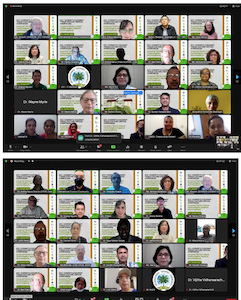 The status of coconut tissue culture technology was recently tackled during the 2nd International Coconut Tissue Culture Virtual Symposium on May 4 to 6, 2022. The symposium was themed, “Coconut Tissue Culture Technologies: Aspects and Prospects.”
The status of coconut tissue culture technology was recently tackled during the 2nd International Coconut Tissue Culture Virtual Symposium on May 4 to 6, 2022. The symposium was themed, “Coconut Tissue Culture Technologies: Aspects and Prospects.”
The International Coconut Community - International Coconut Genetic Resources Network (ICC-COGENT) organized the symposium, in partnership with the Philippine Council for Agriculture, Aquatic and Natural Resources Research and Development of the Department of Science and Technology (DOST-PCAARRD) and the Philippine Coconut Authority (PCA).
DOST-PCAARRD’s strategic support to ICC-COGENT is in line with the Council’s priorities and programs on coconut research agenda under the Harmonized National Research and Development Agenda (HNRDA) for the agriculture, aquatic, and natural resources (AANR) sector. It is also relevant to the target outcome of the DOST-PCAARRD’s Industry Strategic S&T Program (ISP) for coconut to produce quality planting materials that will augment the coconut planting and replanting program, and eventually increase yield and income of the coconut farming communities in the country.
The Council has been providing augmentation funds to qualified professional/scientific and academic organizations that pursue activities in support of the Council’s advocacies, banner programs, and goals
About the coconut tissue culture virtual symposium
This year’s symposium aimed to establish the status of coconut tissue culture technology, including information and technical capacity gaps, needs, challenges, and their application to coconut conservation through knowledge sharing and synergies to support towards achieving more sustainable coconut industry developments. Its specific objectives were the following: 1) knowledge sharing on the advances and challenges of coconut tissue culture technology among the international networks, use for coconut genetic resources conservation and commercial propagation; 2) promote among experts, researchers, farmers, and policy makers the merits of tissue culture in accelerating coconut industry development; o ;l ; 3) unify international experts on coconut tissue culture in bridging gaps and addressing challenges of coconut tissue culture through capacity building and interactive discussions; and 4) provide a strategic platform of technology exchange and transfer, and develop and adopt a mechanism of protecting intellectual property rights.
Experts from various institutions worldwide shared their experiences, insights, and expertise on the status, existing gaps, and challenges of developing the coconut tissue culture technology and socioeconomic benefits of tissue culture to coconut producers and processors. Among these institutions are the Australian Centre for International Agricultural Research (ACIAR), Central Plantation Crops Research Institute (CPCRI), University of Queensland (UQ), Centro de Investigación Científica de Yucatán (CICY), Vietnam National University (VNU), Instituto Nacional de Investigaciones Forestales, Agricolas y Pecuarias (INIFAP), and PCA.
The Symposium had six sessions that focused on the technical aspects of the technology as well as its benefits to stakeholders. Session 1 explained the novel micro propagation method that is based on axillary shoot formation and multiplication and identified bottlenecks and limitations of tissue culture technology, such as lack of fully developed and tested in vitro regeneration protocol, insufficient information exchange, and insufficient funds. In Session 2, cryopreservation was discussed as a promising solution for the long-term conservation of coconut germplasm using plumules, pollen, zygotic and somatic embryos. The use of resistant or tolerant coconut varieties and hybrids was considered as the best approach for managing lethal yellowing-type diseases was discussed in Session 3.
Transboundary spread of pathogens along with germplasm transfer as a major global concern was discussed in Session 4. Meanwhile, it was discussed in Session 5 that production of quality seedling via conventional methods are expensive and time consuming, thus competing in the supply capacity to address the industry demand. Finally, in Session 6, it was emphasized that the economic feasibility studies of the efficiency of the coconut tissue culture protocol have to be established to formulate methodologies and optimize the potentials of the technology. The importance of patent and government collaboration, which can speed up the development of tissue culture protocols was also highlighted. There is also a need to guarantee quality controls and to ensure that benefits can be shared among the participants.
As a way forward, application of tissue culture for coconut genotype selection should be considered in priority plans along with the research on the application of coconut tissue culture technology. This is in support of the germplasm exchange as a major concern of the genetic resources conservation. The symposium recommends that the available coconut tissue culture protocols should be optimized and upscaled as a mass propagation tool in varietal improvement. It is also necessary to establish a network platform for coconut tissue culture to expand plantlet regeneration through international collaboration.
